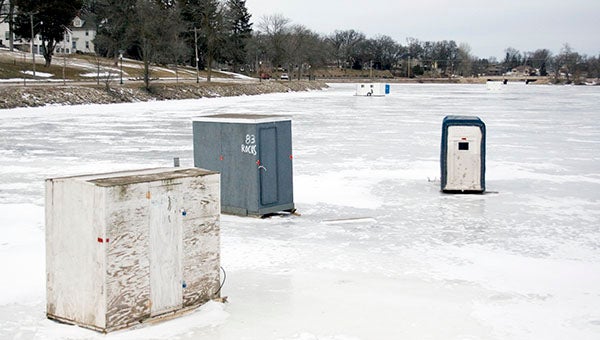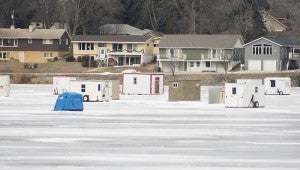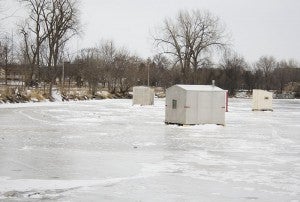Minimal snowfall helping northern pike
Published 12:00 pm Friday, January 25, 2013

Ice fishing houses can be seen on Fountain Lake Thursday in Albert Lea. -- Sarah Stultz/Albert Lea Tribune
Ice fisherman may be finding some more northern pike this winter, despite mass die-offs last summer in southern Minnesota.

Ice fishing houses line part of the shore of Fountain Lake in Albert Lea Thursday afternoon. -- Sarah Stultz/Albert Lea Tribune
The lack of snow cover this winter has allowed sunlight to penetrate ice, caused aquatic plants to grow and helped bolster dissolved oxygen levels, according to Waterville Area Fisheries Supervisor T.J. DeBates. Furthermore, 148,820 northern pike were stocked into the Fountain Lake Watershed in 2012. Albert Lea Lake will receive walleye fry in 2013, as well.
“I think ice fishing has been pretty solid this year in south-central Minnesota,” he added.
Fisherman have been catching northerns on Geneva Lake and are doing well near Faribault, as well. While ice fishing has been rather slow on Albert Lea and Fountain lakes, Mike Conley, owner of The Dam Bait Shop in Albert Lea, said people started catching a few more northerns last weekend.

Ice fishing houses could be seen from the shore of Albert Lea Lake Thursday. -- Sarah Stultz/Albert Lea Tribune
“On Fountain Lake they’ve been catching northerns over the weekend,” he said.
However, not as many people are ice fishing this year, especially during the week.
“It’s been really quiet this week,” Conley added.
Ice fishing is expected to pick back up this weekend with the
Ice Fishing Classic at City Beach in Albert Lea hosted by the Fountain Lake Sportsmen’s Club.
The contest, which goes to support the popular early June event called Take a Kid Fishing, is slated to begin at 1 p.m. Sunday.
The club will give away prizes for the largest fish caught: $100 for first place, $75 for second place and $50 for third place. Other prizes, including a Strike Master ice auger, will also be given away.
DeBates said southern Minnesota will need some late-season snowfalls and early spring and summer rains to help bring lake levels back to where they were.
“On average, the lakes are about a foot to a foot and a half low,” DeBates said.
But if 2013’s summer is similar to 2012’s, with extreme heats, expect more die-offs, he added.


